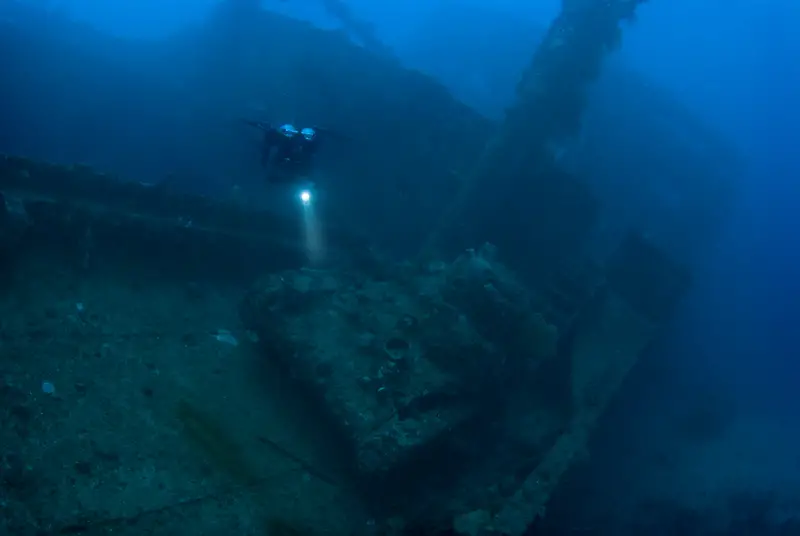Deep beneath the Pacific Ocean, nearly three miles below the surface, lies a time capsule from World War II that recently revealed an unexpected surprise. When researchers from NOAA Ocean Exploration sent remotely operated vehicles to explore the wreckage of USS Yorktown, they weren’t prepared for what they found. Tucked away in the hangar deck of this sunken aircraft carrier was a 1940-41 Ford Super Deluxe “Woody” station wagon. The discovery has left experts scratching their heads. Why was a civilian car aboard a warship heading into one of history’s most important naval battles? And why wasn’t it thrown overboard when the crew was trying to save the sinking vessel?
The unexpected find that shocked researchers
When NOAA researchers sent their underwater cameras into the USS Yorktown’s hangar deck, they never expected to see a car. The Yorktown, an American aircraft carrier sunk during the Battle of Midway in 1942, has been explored multiple times since its discovery in 1998. Yet somehow, no one had spotted this vintage automobile until now. The black 1940-41 Ford Super Deluxe “Woody” was sitting on the aft hangar deck, its distinctive features still recognizable despite decades underwater. The split front windshield, canvas top, chrome bumper, and rear-mounted spare tire all helped identify this classic vehicle.
What makes this discovery so puzzling is that space on aircraft carriers was extremely limited during wartime. Every square foot was dedicated to military equipment, supplies, and personnel. Finding a civilian car in such a setting raises many questions about its purpose and why it remained aboard. The front license plate provided one clue, with the words “SHIP SERVICE ___ NAVY” still visible after all these years. This suggests the car wasn’t just personal property but served some official function on the Yorktown. The car’s presence has become one of the most intriguing mysteries surrounding this famous shipwreck.
Why would a luxury car be on a warship?
Researchers have developed several theories about why this Ford “Woody” was aboard the USS Yorktown. One popular explanation is that it might have been the personal vehicle of a high-ranking officer, possibly Rear Admiral Frank Fletcher, who used the Yorktown as his flagship, or Captain Elliott Buckmaster, the ship’s commanding officer. In the 1940s, it wasn’t unusual for senior naval officers to have personal vehicles available for use when their ships docked at foreign ports. The car would have provided convenient transportation for officers needing to attend meetings or handle business ashore.
Another theory suggests the car might have been brought aboard for repairs after being damaged during the Battle of Coral Sea, which took place about a month before the Battle of Midway. The Yorktown itself had suffered damage during that earlier battle and had undergone hasty repairs at Pearl Harbor. Perhaps the car had been loaded during this repair period and then forgotten in the rush to get back to sea. Whatever the reason, this vintage automobile represents a rare personal touch amid the military equipment that normally filled the carrier’s hangars.
The mystery of why the car wasn’t jettisoned
Perhaps the biggest mystery isn’t why the car was on the ship in the first place, but why it remained there during the Battle of Midway. When the Yorktown was hit by Japanese torpedoes, the crew worked desperately to save the ship, throwing overboard anything that wasn’t essential to keep the vessel from listing too severely. Heavy equipment, furniture, and even some aircraft were pushed into the sea to lighten the ship. Yet somehow, this car remained in the hangar deck. Was there not enough time to remove it? Did it get overlooked in the chaos? Or was there something special about this particular vehicle that made someone want to keep it aboard?
The fact that the car wasn’t jettisoned suggests it might have had significant value, either monetary or sentimental, to someone with authority on the ship. Luxury automobiles were expensive items in the 1940s, especially models like the Ford Super Deluxe “Woody” with its distinctive wooden body panels. During wartime, when many materials were being rationed, such a car would have been particularly valuable. Some researchers speculate that the car’s owner might have hoped to save it, believing the ship would ultimately survive. Sadly, both the ship and the car ended up on the ocean floor, where they’ve remained for over 80 years.
What we know about the Ford Super Deluxe Woody
The car discovered in the USS Yorktown has been identified as a 1940-1941 Ford Super Deluxe “Woody” station wagon. This model was one of the most distinctive and sought-after vehicles of its era. The “Woody” nickname came from its wooden body panels, typically made from maple or birch, which gave the car a unique appearance and premium status. These station wagons were among the most expensive models in Ford’s lineup at the time, costing significantly more than standard sedans. They featured a 3.9-liter flathead V8 engine that produced about 85 horsepower – quite powerful for passenger cars of that period.
Despite decades underwater, several key features of the car are still recognizable in the images captured by NOAA’s remotely operated vehicles. These include its split front windshield (a design feature common in cars of that era), canvas top, chrome bumper, and rear-mounted spare tire. The wooden panels that gave the car its name have largely deteriorated after 80 years in saltwater, but the basic shape remains intact. The front license plate with “SHIP SERVICE ___ NAVY” text suggests this wasn’t just a private vehicle but one officially designated for Navy use. Today, well-preserved examples of these classic Woody wagons can sell for hundreds of thousands of dollars to collectors.
The important role of USS Yorktown in WWII
The USS Yorktown was a crucial vessel in America’s Pacific campaign during World War II. Commissioned in 1937, the Yorktown was an Essex-class aircraft carrier that played pivotal roles in several major battles. Before its sinking, the Yorktown had participated in the Battle of the Coral Sea in May 1942, where it helped stop a Japanese invasion fleet headed for Port Moresby, Papua New Guinea. Though damaged in that battle, the ship was quickly repaired at Pearl Harbor and sent back to sea just days later to participate in the Battle of Midway, which would prove to be a turning point in the Pacific war.
At Midway, aircraft from the Yorktown helped sink the Japanese carrier Sōryū before the American ship was hit by Japanese torpedoes. Despite valiant efforts to save the vessel, the Yorktown eventually sank on June 7, 1942. The ship now rests approximately 3 miles deep in the Pacific Ocean, about 1,000 miles northwest of Hawaii. The loss of the Yorktown was a significant blow, but the American victory at Midway changed the course of the war in the Pacific. The Yorktown and its crew’s sacrifice contributed to a decisive victory that marked the beginning of Japan’s retreat in the Pacific theater.
Other surprising discoveries on the Yorktown wreck
While the Ford “Woody” car has grabbed headlines, it wasn’t the only surprising find made during NOAA’s recent exploration of the USS Yorktown wreck. Researchers also discovered a hand-painted mural inside one of the ship’s elevator shafts, depicting a world map that tracked the Yorktown’s global voyages. This artistic creation offers a personal glimpse into life aboard the carrier and how sailors recorded their travels. The mural survived decades underwater, protected inside the elevator shaft from ocean currents and marine life that might otherwise have erased this piece of history.
The expedition also located several aircraft still in remarkably good condition, including Douglas SBD Dauntless dive bombers that flew from the Yorktown during its final battle. One dive bomber was found with a bomb still secured in its release cradle, ready for a mission that never took place. These planes were the same model that delivered the decisive blows against Japanese carriers at Midway. Beyond military equipment, researchers observed how the wreck has become home to various marine life, including a bright red jellyfish that might be a previously unknown species. These deep-sea discoveries show how shipwrecks transform into artificial reefs and habitats for ocean creatures.
The ongoing search for answers about the mystery car
NOAA researchers aren’t content to simply marvel at their unexpected automotive discovery – they’re actively seeking answers about why the car was aboard the Yorktown and why it wasn’t jettisoned. They’ve reached out to car enthusiasts, naval historians, and World War II experts for insights that might explain the vehicle’s presence. The agency has shared images of the car online, hoping someone might recognize unique features or have records that could solve the mystery. They’re also searching naval archives for any mention of vehicles assigned to the Yorktown or requisition forms that might explain how a luxury station wagon ended up on an aircraft carrier bound for battle.
The mystery car has captured public imagination, with thousands of people offering theories and suggestions. Some have pointed out that wooden-bodied station wagons were sometimes used as ambulances during the early war years, suggesting the car might have had a medical purpose. Others have found records of similar vehicles being used as officer transport or for carrying sensitive communications. Whatever its purpose, this car offers a tangible connection to the people who served aboard the Yorktown. Behind every piece of military equipment were individuals with personal stories, and this car represents one such untold story from America’s greatest naval generation.
The story of the Ford “Woody” car found in the USS Yorktown wreck reminds us that history is never completely written. Even after 80 years, new discoveries can change our understanding of the past or raise intriguing questions we never thought to ask. The mystery of why this luxury automobile was aboard a warship heading into battle may never be fully solved, but its discovery helps us see the human side of war. Behind the dates, battles, and statistics were real people who brought pieces of civilian life with them into conflict. The search for answers continues, ensuring that the stories of the USS Yorktown and its crew will not be forgotten.

